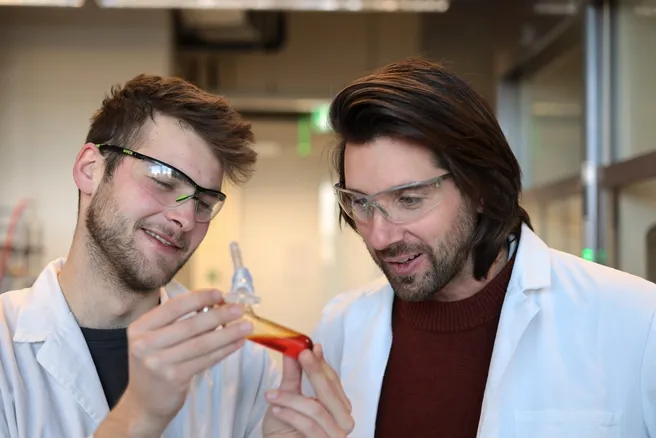They show a molecularly engineered bimetallic interface that uses only earth-abundant metals to achieve cooperative hydrogenation catalysis, highlighted in Chem (Cell Press). As a scientific community, we continuously address the challenge of sustainability. To synthetic chemists this means making processes “greener”: using more abundant elements, requiring less energy and generating less waste. Catalysis, the central focus of TUM’s Catalysis Research Centre (CRC), is used extensively in research and industry to achieve chemical reactions that are otherwise not possible. These concepts also help to reduce energy requirements and waste generation, and to create innovative materials in line with TUM research area “Materials and Manufacturing Technologies”.
However, most applied catalysts currently rely on unsustainable precious metals and are often poorly understood. Inspired by cooperative interactions found in natural systems, the Hadlington research group develops catalysts that leverage the synergistic effects of multiple metal sites working together in an engineered molecular space. In recent work published in Chem, the team describes their discovery of a combination of gallium and nickel, both earth-abundant metals, which work together in a molecular complex to easily and reversibly break the strong bond between two hydrogen atoms in H2. This “activation” is necessary to use the hydrogen atoms as synthons in chemical synthesis.
A central finding of this work uncovers a previously unknown pathway for the activation of this key molecular building block, achieved by designing and engineering spatially confined metal-metal bonding. The Hadlington team demonstrates that their bimetallic system can catalytically transfer the H2 molecule in the alkyne semi-hydrogenation reaction, which is an important reaction used in industry for the selective synthesis of alkenes. Alkenes are used to produce various key chemicals, such as alcohols, ketones, glycols, olefin oxides, plastics and detergent components used in polymer-, pharmaceutical- or agro-chemistry.
In the presented study, analysis of key details in this reactive pathway sheds light on these new cooperative bond activation and atom transfer reactions. These factors allow their bimetallic catalyst to achieve this important waste-free catalytic reaction with very low energy demands. This introduces a new concept for the efficient use of abundant metals in bimetallic cooperative catalysis, inspired by spatial constraint found in nature, giving us further tools to address the greater challenge of sustainable chemical synthesis.
Publication Cell Press: “Cooperative hydrogenation catalysis at a constrained gallylene-nickel(0) interface”(DOI: 10.1016/j.chempr.2024.10.016)
Further information and Links
Press contact

